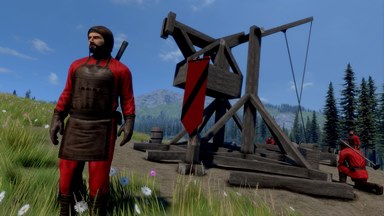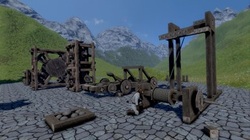Keen:Who Are Medieval Engineers
 OFFICIAL CONTENT OFFICIAL CONTENT |



A medieval engineer is an inventor and professional practitioner who uses scientific knowledge, mathematics, physics, metallurgy, materials science, structural analysis, manufacturing, craftsmanship and ingenuity to solve the practical problems involved in constructing buildings and mechanical systems. Medieval engineers design materials, structures and systems while considering the limitations imposed by practicality, safety, ethicality and cost. Medieval engineers perceive their mission as the transformation of raw materials in to something that has a designed purpose.
Medieval engineers take their inspiration from the technology and innovations of the ancient Greeks and Romans, and consider themselves to be their disciples.
Practical solutions
- Engineering, construction and maintenance of architectural and mechanical works: fortifications, castles, cathedrals, protection walls; defense, siege and assault machinery (military technology such as catapults, trebuchets, traps); construction machinery such as cranes and pulleys, transportation carriages and machines
- Underground mining (mostly near a construction site), wood harvesting, digging and land reclamation works
- Industry – metallurgy and metal manufacture
- Maintaining lines of transportation and communication (fire signals and beacon networks)
- Industrial and scientific research, development and exploration
Fields of interest
- Architecture
- Construction management
- Construction engineering
- Chemical engineering
- Civil engineering
- Materials engineering
- Mechanical engineering
- Urban planning
- Military engineering
Military Engineering
War has been eternal since the dawn of man, so medieval engineering has also been used for military applications. Such tasks typically include construction and demolition under combat conditions.
Military engineers use the practices and techniques of camouflage, reconnaissance, and communication, and develop methods to enhance survivability for allied troops. They are also responsible for construction rigging, camouflage erection, war machine construction and design, field fortification construction, artillery outpost construction, obstacle clearance, obstacle construction, assault of fortifications, the use of assault engines and machinery in obstacle crossings, expedient outposts construction (military and trading), general construction, route reconnaissance, and communication installation. They are also responsible for the logistics that support military operations.
Medieval engineers are in a high demand and are extremely valued by rulers and military leaders. They take pride in their ability to get the job done right—no matter how big, how complex or how remote.
The word “engineer” derives from the Latin root ingeniare (“to contrive, devise”) and ingenium (“cleverness”).
— Encyclopedia of the Brethren of Purity and Loyal Friends, 1415 —